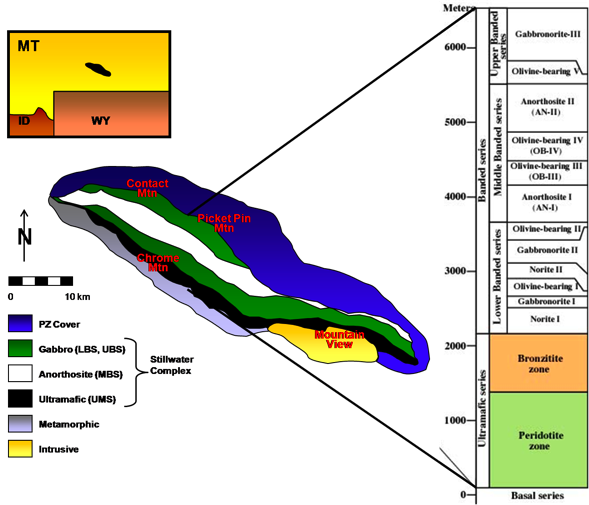Characterization and Origin of Discordant Harzburgites and Dunites in the Ultramafic Series of the Stillwater Complex, Montana


Mapping dunite and harzburgite bodies in the Stillwater Complex, Montana
ABSTRACT
The Stillwater Complex is a large layered igneous intrusion located in southwest Montana. It is exposed for nearly 50 km along strike and up to 6.5 km in stratigraphic thickness. Above a basal chilled zone, the complex is composed of ultramafic cumulates that grade from orthopyroxenite into harzburgites and dunites over a thickness of ~150 meters. Above this sequence are another ~800 meters of mostly dunites and harzburgites and then ~1000 meters of orthopyroxenites before mafic cumulates occur. The focus of this work is on bodies of harzburgite ± dunite that cut the lower orthopyroxenites and are discordant to the igneous layering. Detailed outcrop mapping at a scale of 1:200 reveals that the contacts between the host orthopyroxenite and the discordant bodies are sharp – on the order of a few grain diameters. In the mapped areas, harzburgite almost always separates the host orthopyroxenite from the dunites. Locally, chromite selvages of centimeter scale occur at the boundary of the discordant bodies. The sharp contacts and irregular grain boundaries of these bodies are indicative of replacement of the orthopyroxenite host. The lack of deformation in the host rock suggests that the replacement of the host orthopyroxenite was isovolumetric or nearly so. Two models for the origin of the discordant bodies are tested using petrographic and chemical methods: (1) The discordant bodies formed during a magma recharge event when primitive basaltic liquids reacted with orthopyroxenite wall rocks through which they migrated. and (2) The discordant bodies were formed by the channelized flow of reactive hydrous fluids. The presence of pegmatoids (coarse grained gabbronorites) both within and structurally above the discordant bodies and a large domain of plagioclase (up to 15 cm) in the dunites, both suggest that fluids were important in their genesis. The bulk Ni content of the dunites are about 2-3 times higher than that of the host orthopyroxenite requiring some addition of Ni but indicating that these olivines were not in equilibrium with a liquid more primitive than that from which the orthopyroxenite crystallized. The bulk rock K content is high for some discordant rocks, but not all, and for some of the host orthopyroxenites. This may indicate that chemical modification of the rocks precedes mineralogical modification during the replacement process(es) and that complete conversion effectively eliminates incompatible elements from the bulk rock.

Location and stratigraphy of the Stillwater layered intrusion.

Research in the Stillwater Complex was an undergraduate research project under the supervision of W.P. Meurer at the University of Houston.
Sunset from camp in the Stillwater Complex


Plagioclase bearing pegmatoid from Chrome Mountain in the Stillwater Complex, Montana.
Chrome seam separating the hartzburgite (top) from the orthopyroxenite (bottom).

